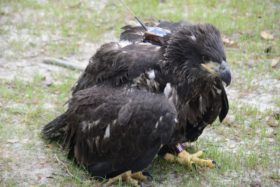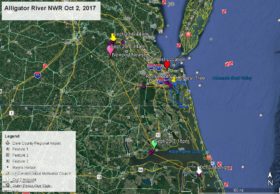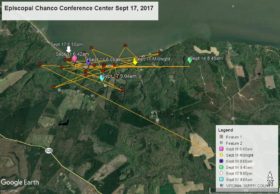Banding Day April 21, 2011
Azalea on North Landing River
April 16, 2011Learning to Feed Oneself
April 18, 2011

This is the first hatch eaglet at NBG taking a good look at her(?) big feet and legs. At five weeks of age the three nestlings have really grown and are now large enough to have identification braclets placed on their lower legs called the tarsus. Eagles take size 9 rivet bands issued by the US Geological Survey Bird Banding Lab. The band will have an individual 9 diget number (0679-XXXXX). A second band colored purple will be placed on the other leg and will identify the eagle as having been banded in the Chesapeake Bay region and will have a 2-letter alpha ID. For information about the U.S. bird banding program go to this web site www.pwrc.usgs.gov/bbl. For information about eagle banding in Virginia by The Center for Conservation Biology see www.ccb-wm.org/virginiaeagles. The bands pictured above are those placed on the three NBG eaglets in 2010.
The banding of the three Norfolk Botanical Garden bald eagle chicks is planned to take place on April 21, 2011 beginning about 9:00am. The actual banding should take place about 9:30. Nuckols Tree Care will volunteer their tree climbing services to lower the eaglets safely to the ground where biologists from CCB will examine, weigh and measure them and fit them with bands. The Virginia Dept of Game and Inland Fisheries will provide a photographer and videographer and Stephen Living, Watchable Wildlife Biologist, will be present to assist. WVEC will broadcast the banding event over the live eagle cam at www.wvec.com/eaglecam.




7 Comments
I am just so excited to be able to watch this remarkable event. I, actually, have an old friend who worked for South Carolina Wildlife until his retirement. When I showed him the eagle cam, he said “oh yeah, I used to band all over the State of SC. That was quite a few years ago when they were really endangered. Couldn’t talk long, so I am anxious to see him again and get his experiences. Nature is awesome!!!
Reese, I will be joining you online, once again, for the banding! Great thanks for enabling so many to be a part of this experience.
I have a question re osprey, if you don’t mind answering…We live in a lake community, TX Gulf Coast area, and have had the thrill of watching a beautiful osprey nearby! Recently, it has been absent from its usual places. Could it be nesting/egg-laying time? Or, would it have migrated from our area, abt 40 mi N of Houston?
Response – In Texas Osprey should have been nesting and have chicks in the nest by now.
how did they turn black
Thanks so much for today, Reese – you guys did a fantastic job and it was really great to see the joy on your face. Nothing like a biologist who LOVES his work!
where is the link to see the video of today’s banding?
Response – The video of the banding is being edited. When ready it will be posted on VA DGIF web site.
First of all, thank you so much for the wonderful experience of these eagles and their babies! This is the first year I have watched from before eggs being laid till now and it is just such an awesome experience! I have watched in previous years but always from later in the season. Never watched the banding process live. I live in Hampton, Virginia and couldn’t decide whether to come over and see it live or watch online. I finally decided that I’d see it better online so I stayed home. At about the point where Julian was lowering the third eaglet both of my cams went out and no amount of refreshing would bring either one back! I know that you will be posting a video of the banding but is there any way that you will also be posting the video from the tree cam so that those of us who missed it can see Julian when he takes a picture of himself with eaglets! Thank you in advance and also thank you for all you do for these wonderful eagles!
Response – Both DGIF and NBG will post videos as soon as the video is edited to a viewable length.
I don’t know how to tell you how much this Eagle Cam has meant to me. I am 61 and watching the eaglets grow, seeing how much you and CCB, VDGIF and NBG care helps me realize there are still good people in our world. I have learned so much from all of you and the wonderful moderators who give so much of themselves to all of us.
I am going to be sad to watch them fledge, but will follow your blog and others in hopes that our three “youngsters” will be spotted and we will know how they spend their lives.
Thank you for the bottom of my heart.